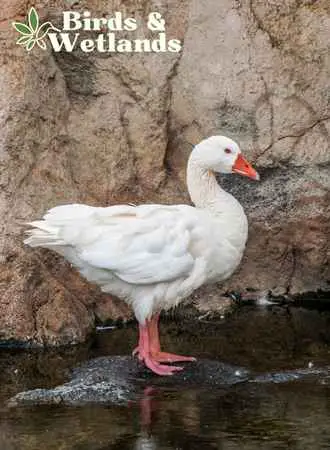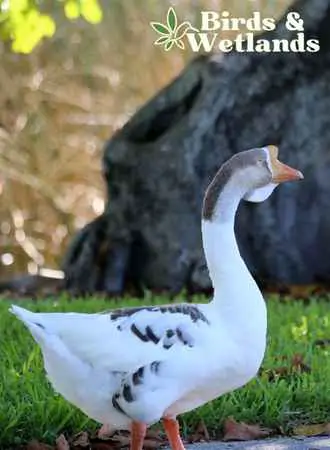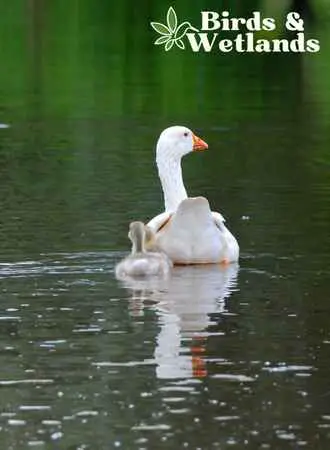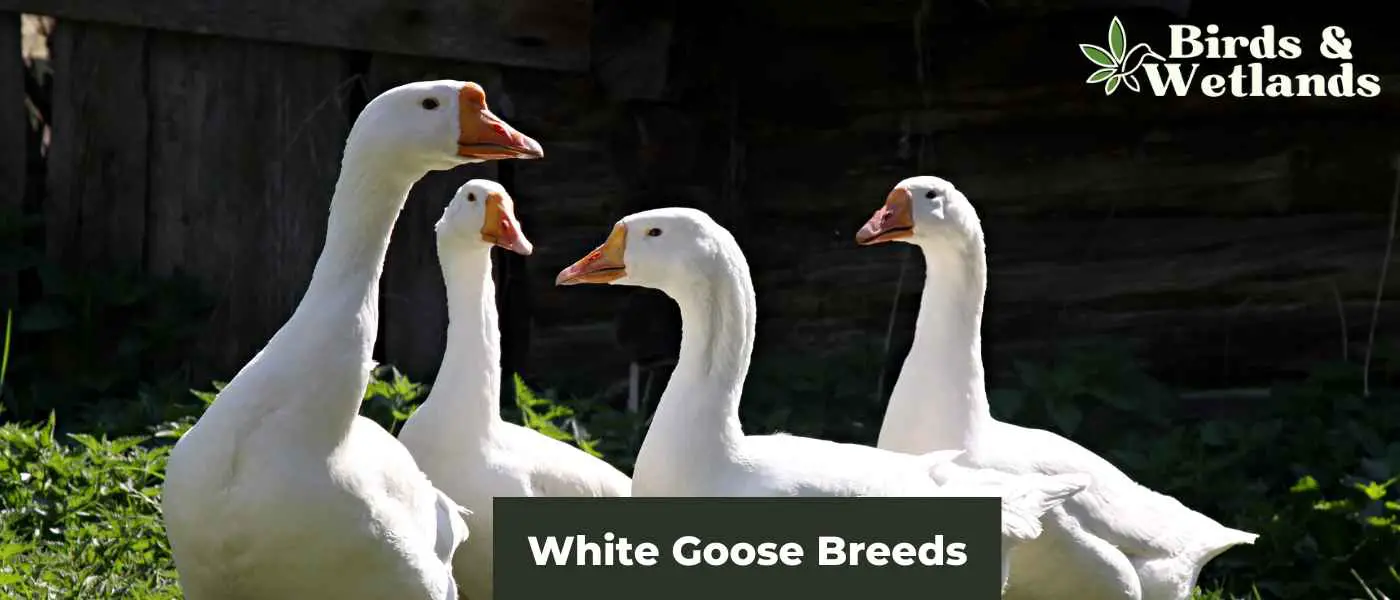Think all geese are white? You’re not alone!
In fact, white-feathered geese are some of the most common and best-known in North America. Geese have been used for food and feathers for centuries, and there’s a lot to know about these interesting birds. Keep reading to learn everything you need to know about white geese!
Genus Anser
The genus Anser encompasses a wide range of birds, including grey and white geese. This diverse group is part of the true geese and swan family (Anserinae), widely distributed across the Northern Hemisphere. These birds are distinguished by their adaptability, with many species thriving in habitats ranging from freshwater lakes and streams to coastal marshes and grasslands.
Regardless of their specific habitat preferences, Anser geese have several key physical features in common, including long necks, webbed feet, large heads, and powerful bills. Their adaptations help them be successful waterfowl that are an important part of many ecosystems worldwide.
Not all white geese are domestic geese. For instance, snow geese are wild geese that breed in the Arctic and spend winters in various parts of the southern United States.

Domestic Geese
A domestic goose is a bird humans have domesticated and kept for various purposes. Generally, these birds have been bred from two species: the wild greylag goose (Anser anser domesticus) and the wild swan goose (Anser cygnoides domesticus).
Domestic geese are raised primarily for their meat, eggs, or down feathers, used for various purposes such as insulation or stuffing pillows. They are also commonly kept in zoos, farms, and private backyard flocks.
Compared to other types of fowl, such as chickens or ducks, geese are known for their hardiness, intelligence, and loyalty. Some of these geese have special traits such as being sexually dimorphic like the Pilgrim goose. Additionally, domestic geese have been raised for fecundity, with females laying up to 50 eggs annually.
Most domesticated geese went through selective breeding. Variable changes have been made to the plumage, with many selected to eliminate the dark brown tones of the wild geese. The result is an animal marked with white feathers or completely covered with them. Over time, many domestic breeds lost their darker or browner tints.
If you plan on keeping a flock of domestic geese in your backyard, make sure to get either two female geese or one female and a male. Additionally, nest boxes are not required when raising geese, as the female goose simply collects nesting material.

Chinese Goose
The Chinese goose is a unique domestic goose breed prized for its high-quality meat and feathers. It has an erect posture and a fat rear end.
Originating in China, this breed belongs to a group of geese known as knob geese, whose distinguishing feature is a prominent basal knob on the upper bill. With over twenty different breeds of knob goose in China alone, the Chinese goose is one of the world’s most highly-regarded and widely-used breeds. As such, it is an important agricultural species that provides valuable products for both farmers and consumers.
There are two Chinese geese available in North America — the white Chinese geese and the brown Chinese geese.
African Goose
The African goose is a distinctive breed of domestic goose originating from the wild swan goose. It is among the largest geese breeds. Unlike its namesake, the African goose is not native to Africa but rather descended from the Chinese goose. This large, heavy bird has a wide body, a long, thick neck, and a prominent knob on its forehead. While adults usually range in size between 18 and 22 pounds, males tend to be taller than females. Due to their docile temperaments and large size, African geese are often bred for meat production or feather harvesting on farms. Although docile most of the time, males are particularly aggressive during the breeding season.

White Toulouse Geese
The Toulouse goose is a breed of domestic goose that hails from the area of Toulouse in southwestern France. It is typically larger than other breeds and were originally bred for exhibition purposes. The production strain of the Toulouse goose was carefully bred to be fast-growing, allowing farmers to maximize profits by packing the birds full of weight and fat when food is abundant, but there is no room for exercise. This fattened bird produces high-quality meat, delicious goose fat, and valuable foie gras, making it a valuable commodity in the poultry industry. Additionally, Toulouse geese may be raised for their down feathers, which make excellent insulation for clothing or bedding materials.
Buff Toulouse geese are a beautiful variety of geese characterized by their buff-colored plumage. Their abdomens are white, their eyes are hazel, and a light orange bill and feet. They also have strong wings and large bodies.

American Saddleback Pomeranian
The American Saddleback Pomeranian goose is a beautiful breed of domestic goose. These geese are prized as ornamental birds due to their light gray or beige colored head, back, flanks, and distinctively colored tail with feathers that are edged in near-white. While these geese were originally bred in America for commercial meat production, today, they are mainly raised as ornamental birds. Their elegant appearance and bright plumage make them popular additions to local farms and gardens.
Sebastopol Goose
The Sebastopol is a unique breed of domestic goose, known for its long, white, curly feathers and orange legs. Originating from Europe, this breed has a distinct appearance that sets it apart from other domestic geese. Due to its feathers’ frizzy or curly nature, the Sebastopol is not capable of flight, making it an ideal choice for people interested in keeping geese but without access to large open spaces. Variants of Sebastopol goose include all-gray, buff, saddleback and white variety.

American Buff Goose
The American Buff goose is a breed of domestic goose raised in the United States for many years. The American Poultry Association first recognized this breed in 1947. It gets its name from its distinctive single-color variety, an apricot or fawn hue rather than literally buff. American Buff geese are medium-weight birds known for their calm, docile disposition and are popular among small farmers and hobbyists. They are a dual-purpose breed, raised for their meat and eggs.
Embden Goose
The Embden goose is a prized breed of domestic goose originating in Germany. It is named for the town of Emden, which lies in the northwesternmost part of the country. Embden geese are popular worldwide for their large bodies and fast growth. They are prized both for their meat and eggs, which are said to be of excellent quality. They have white plumage, blue eyes, a short orange bill, an oval-shaped head, and a long neck and back.

Steinbacher Goose
The Steinbacher goose is a rare breed with many distinct and unique characteristics. These geese are known for their upright posture and lack of keel or dewlap, as well as their strikingly colored orange bills, black lips, and ringed eyes. They are also known for their impressive egg-laying abilities, laying anywhere from 30 to 50 large white eggs per year.
However, these birds can be somewhat finicky when sitting on their eggs, sometimes requiring assistance from their human caregivers to hatch the clutch successfully. Nevertheless, these hardy geese make excellent parents and have been widely recognized for their ability to graze for much of their food intake.
Due to their rarity in the US, conservation efforts surrounding the Steinbacher would help this unique breed thrive in modern farming practices.
Key Points
Many domestic geese have been selectively bred for size, meat and egg production.
Modern breeds of domestic geese with completely white plumage color were once gray or dark brown.
Most domestic geese are excellent foragers, able to find food on their own.
FAQs on White Goose Breeds
Do domestic geese fly?
Domestic geese come in various shapes and sizes, each with unique physical features. However, regardless of their appearance or size, most breeds of domestic geese are naturally capable of flight. Light weight breeds can fly short distances. And even the heaviest breeds can take to the air if they have enough room to do so – and in fact some larger breeds, such as the Toulouse goose, have been bred specifically for large size and high weight.


